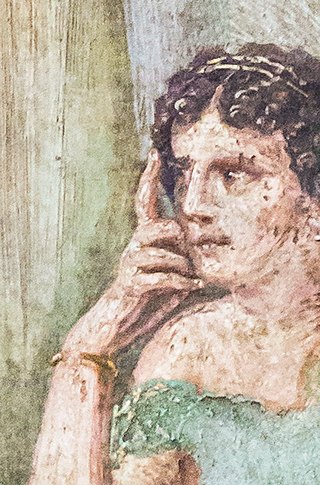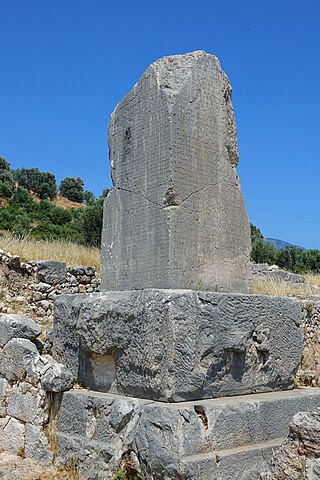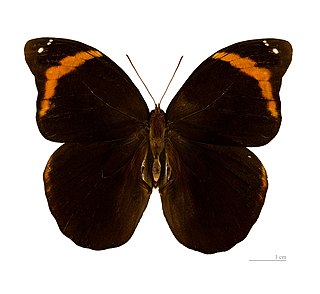Related Research Articles

Thetis is a figure from Greek mythology with varying mythological roles. She mainly appears as a sea nymph, a goddess of water, and one of the 50 Nereids, daughters of the ancient sea god Nereus.
Mopsus was the name of one of two famous seers in Greek mythology; his rival being Calchas. A historical or legendary Mopsos or Mukšuš may have been the founder of a house in power at widespread sites in the coastal plains of Pamphylia and Cilicia during the early Iron Age.

Balius and Xanthus were, according to Greek mythology, two immortal horses, the offspring of the harpy, Podarge and the West wind, Zephyrus. In other traditions, Poseidon is the father of Xanthus along with another horse named Cyllarus to an unnamed mother. It is possible that Xanthus's ability to speak prophetically may be related to Arion, another mythical horse reported to have saved Adrastus from the war of the Seven against Thebes with his prophetic abilities in Statius's Thebaid.
Xanthus or Xanthos may refer to:

Xanthos or Xanthus, also referred to by scholars as Arna, its Lycian name, was an ancient city near the present-day village of Kınık, in Antalya Province, Turkey. The ruins are located on a hill on the left bank of the River Xanthos. The number and quality of the surviving tombs at Xanthos are a notable feature of the site, which, together with nearby Letoon, was declared to be a UNESCO World Heritage Site in 1988.

In Greek mythology, Automedon, son of Diores, was Achilles' charioteer, who drove the immortal horses Balius and Xanthos.

Thom Kallor is a character appearing in comic books published by DC Comics, primarily as a member of the Legion of Super-Heroes. The character has also been known as Star Boy and Starman.

USS Xanthus (AR-19) was a Xanthus-class repair ship acquired by the United States Navy for the task of providing repairs to the fleet. She was named after Xanthus, a mythical beast of Greek legend.

Myxococcus xanthus is a gram-negative, rod-shaped species of myxobacteria that exhibits various forms of self-organizing behavior in response to environmental cues. Under normal conditions with abundant food, it exists as a predatory, saprophytic single-species biofilm called a swarm. Under starvation conditions, it undergoes a multicellular development cycle.
Xanthus of Lydia was a Greek historian, logographer and citizen of Lydia who, during the mid-fifth century BC, wrote texts on the history of Lydia known as Lydiaca (Λυδιακά), a work which was highly commended by Dionysius of Halicarnassus. Xanthus also wrote occasionally about geology. It is believed that Xanthus was the earliest historian to have written a significant amount on the topic of Lydian history. He is also believed to have written a work entitled Magica (Mαγικά), as well as one entitled Life of Empedocles. It is believed that Xanthus had some knowledge of Persian traditions, and it is plausible that he, a Lydian, would write about Persian religion, but it seems unlikely due to the available evidence. His seat was believed to be at Sardis, the capital. A contemporary and colleague of Herodotus, most of his writings concerned the lineage and deeds of the Lydian kings. Xanthus was known for writing in the traditional Ionian style of trying to establish the scene of popular myths. One example of Xanthus using this type of writing style is when he placed the scene of the "giant's punishment" in Katakekaumene. Xanthus was also known for adapting historical events that were often considered boring into passages that the general Greek public would enjoy. Xanthus was one of the chief authorities used by Nicolaus of Damascus.

4544 Xanthus, provisional designation 1989 FB, is an asteroid, classified as near-Earth object of the Apollo group, approximately 1.3 kilometers in diameter. It was discovered on 31 March 1989, by astronomers Henry Holt and Norman Thomas at the Palomar Observatory in California.

The Xanthus-class repair ships were a class of five auxiliary ships built for the United States Navy and Royal Navy. Ships of the class served in a diverse range of environments in varying capacities during both World War II and the Korean War. Xanthus-class ships were in commission between 1945–1955.

The Xanthian Obelisk, also known as the Xanthos or Xanthus Stele, the Xanthos or Xanthus Bilingual, the Inscribed Pillar of Xanthos or Xanthus, the Harpagus Stele, the Pillar of Kherei and the Columna Xanthiaca, is a stele bearing an inscription currently believed to be trilingual, found on the acropolis of the ancient Lycian city of Xanthos, or Xanthus, near the modern town of Kınık in southern Turkey. It was created when Lycia was part of the Persian Achaemenid Empire, and dates in all likelihood to ca. 400 BC. The pillar is seemingly a funerary marker of a dynastic satrap of Achaemenid Lycia. The dynast in question is mentioned on the stele, but his name had been mostly defaced in the several places where he is mentioned: he could be Kherei (Xerei) or more probably his predecessor Kheriga.

Catoblepia xanthus is a butterfly of the family Nymphalidae. It is found in northern South America.
In Greek mythology, the name Xanthus or Xanthos may refer to:
Tragocephalini is a tribe of longhorn beetles of the subfamily Lamiinae. It was described by James Thomson in 1857.
Spilotragus guttatus is a species of beetle in the family Cerambycidae. It was described by Stephan von Breuning in 1934.
Spilotragus ornatus is a species of beetle in the family Cerambycidae. It was described by Charles Joseph Gahan in 1898.
Spilotragus variabilis is a species of beetle in the family Cerambycidae. It was described by Karl Jordan in 1897.
Arsada or Arsadus was a city of ancient Lycia, located over the valley of the Xanthus between the ancient cities of Tlos and Xanthus.
References
- ↑ BioLib.cz - Spilotragus xanthus. Retrieved 8 September 2014.